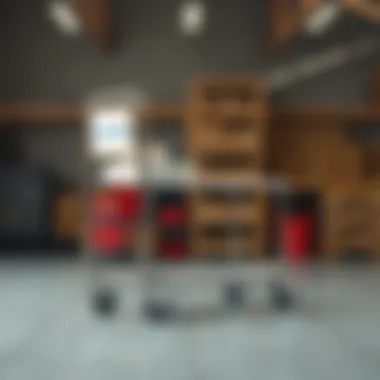In-Depth Analysis of Metal Roller Carts and Their Uses


Intro
Metal roller carts have become vital in various contexts, transforming how we think about organization, efficiency, and mobility. From homes to industrial settings, these utility carts are more than just functional pieces; they embody a certain character and practicality that resonates with modern life. This article sets out to explore these essential carts, diving into their design traits, durability, and the myriad of ways they can enhance spaces.
The interplay between style and functionality cannot be overstated, especially when dealing with a product that caters to diverse environments. Therefore, understanding the types of metal used in creating these carts, alongside their aesthetic appeal, is pivotal. This brings us to the first major area of focus.
Furniture Styles and Trends
Modern vs. Traditional: Understanding the Aesthetics
When discussing metal roller carts, it is crucial to address the differing aesthetic philosophies of modern and traditional styles. Modern designs often lean toward minimalism, featuring clean lines and sleek finishes. Materials tend to be polished stainless steel or powder-coated metal which reflects a contemporary theme. In contrast, traditional carts often embrace a more elaborate approach, featuring ornate details and warm finishes, like wrought iron or brushed brass.
The decision between modern and traditional largely depends on the target environment. In contemporary kitchen spaces, a sleek stainless steel cart might complement a polished countertop beautifully, while in a rustic home setting, a distressed metal cart could accentuate the warmth of wooden elements.
Key Points of Consideration:
- Style Compatibility: Assess how the cart's design fits with existing furniture.
- Visual Weight: A cart's materials and finish can significantly affect its presence in a room.
Color and Material Trends: What's In and What's Out
The colors and materials trends in metal roller carts are always evolving. Currently, matte finishes in deep colors such as forest green or burnt orange are gaining popularity. These tones contribute to a cozy atmosphere while also providing a touch of modernity that many homeowners find appealing.
When it comes to materials, sustainability is at the forefront. Cart designs are increasingly featuring recycled metals, signaling a shift towards eco-friendly options. Steel remains the go-to for durability, but we also see a rise in aluminum for lightweight, portable carts that don’t compromise on sturdiness.
Important Trends to Note:
- Matte Finishes: Preferred for their understated elegance.
- Sustainable Materials: More consumers opting for recycled options.
Furniture Care and Maintenance
Tips for Prolonging the Life of Your Furniture
Taking care of metal roller carts involves more than just routine cleaning. Regular maintenance can drastically enhance the lifespan of these carts.
- Cleaning: A gentle soap and water solution works wonders. Avoid harsh chemicals that can strip away the protective layers.
- Rust Prevention: If your cart has a scratch or dent exposing bare metal, apply a coat of clear sealant to prevent rusting.
- Mobility Maintenance: Periodically check the wheels. A little grease can keep the wheels rolling smoothly.
DIY Repair Hacks for Common Furniture Issues
Metal roller carts are generally durable, but accidents happen, and repairs can keep them functional and aesthetically pleasing.
- Scratch Repair: For minor scratches, use a metal touch-up pen that matches the cart's color. This can conceal imperfections and maintain its appearance.
- Wobbling Wheels: Tighten any loose screws or replace worn-out wheels with sturdy ones to ensure smooth navigation without a hitch.
- Rust Removal: Use fine steel wool to buff out rust spots gently, then repaint for a fresh look.
"Keep your carts in top-notch condition to enjoy their benefits for years to come. A little effort goes a long way!"
In summary, metal roller carts are a practical choice for varied environments, combining functionality with aesthetics. By staying updated on trends and practicing proper maintenance, users can significantly enhance their usability and lifespan. As we further explore the intricacies of metal roller carts, the potential applications in diverse spaces come to light, reinforcing their value in everyday life.
Prelims to Metal Roller Carts
Metal roller carts have become an essential fixture in various settings, from bustling kitchens to polished retail floors. They serve as versatile tools designed to assist with organization and mobility. Understanding metal roller carts is important for anyone who looks to enhance functionality in their daily tasks or business operations. Whether you're a homeowner aiming to declutter or a retailer wanting to streamline customer service, these carts offer practical solutions.
Definition and Overview
A metal roller cart can be defined as a wheeled utility cart primarily constructed from metal materials. They typically feature multiple shelves or compartments, allowing for the easy transportation of goods, utensils, or tools. The design often incorporates sturdy wheels for movement, making them ideal for transporting heavy loads across various environments.
These carts can be found in diverse forms, catering to specific needs. For instance, a kitchen utility cart often has space for pots and pans, whereas a retail cart is designed to display merchandise appealingly. The flexibility in design allows users to select a cart that fits their particular requirements, be it for organization, display, or transport.
Historical Context
The origins of metal roller carts can be traced back to the industrial revolution when manufacturers started utilizing metal for its durability and strength. Initially, these carts were employed in factories and warehouses to handle raw materials and finished goods. The basic design has evolved over the decades to suit a wide range of applications.
In the mid-20th century, as consumer culture blossomed, the proliferation of retail businesses prompted innovations in design. Retailers sought solutions that would both serve their logistic needs and enhance customer experience. Roller carts began appearing in various shapes and sizes, adapting to the demands of different sectors.
Notably, the introduction of lightweight metals, such as aluminum, transformed the way carts were used, making them more accessible for everyday consumers. Today, metal roller carts symbolize efficiency in the fast-paced environments of retail, service, and home life, bridging the gap between convenience and durability.
"The evolution of metal roller carts reflects an ongoing demand for convenience paired with strength, making them a crucial element in modern organizational systems."
Understanding these carts is more than just recognizing their practical uses; it paints a picture of their significant role in enhancing workflow efficiency, whether in a commercial space or home environment.
Materials in Metal Roller Carts
The materials chosen for metal roller carts play an integral role in defining their functionality, durability, and overall design. When selecting a metal roller cart, understanding the materials involved is crucial not just for strength but also for usage across different environments. The choice of material can influence everything from load capacity to aesthetic appeal, making it a key decision for homeowners, designers, and retailers alike.
Common Metals Used
Steel
Steel is often regarded as the sturdy workhorse in the realm of metal roller carts. With its high tensile strength, steel provides remarkable durability and allows carts to manage heavy loads with ease. One of its key characteristics is that it can withstand significant wear and tear, making it a popular choice especially in industrial settings.
A notable feature of steel is its ability to be molded into various forms during production, allowing for versatile designs that can adapt to different functionalities. However, it is worth mentioning that steel can be prone to rust if not properly treated. This drawback can be mitigated by applying protective coatings, although such additional steps do add to the manufacturing costs.
Aluminum
Aluminum presents a lightweight alternative to steel. One of its standout traits is corrosion resistance, which prevents it from oxidizing when exposed to moisture and other environmental factors. This property makes aluminum ideal for carts that will be used in environments like kitchens or outdoors, where exposure to elements is a concern.
The unique feature of aluminum carts lies in their portability; they can be easily maneuvered compared to their steel counterparts. However, they may not handle extreme weights as effectively, limiting their application in some industrial settings. Still, for many everyday uses, aluminum roller carts strike a fine balance between function and lightness.
Stainless Steel


In the middle ground lies stainless steel, melding the durability of steel with added corrosion resistance. Its key characteristic is its aesthetic appeal—often shiny and modern-looking, stainless steel adds a touch of elegance that suits both professional and residential environments. Its composition makes it resistant to corrosion, allowing for longevity and minimal maintenance.
A unique benefit of stainless steel is its hygiene factor, making it a preferred option in healthcare settings where cleanliness is a top priority. However, the increased cost associated with stainless steel compared to regular steel and aluminum can be a hindrance for some buyers. Despite this, it often proves worthwhile for those who prioritize both durability and style.
Factors Influencing Material Choice
As we consider how to best suit the needs of various users, several factors come into play in the selection of materials for metal roller carts.
Weight Capacity
When delving into the world of metal roller carts, weight capacity is perhaps one of the most pressing factors. It defines how much load a cart can carry without compromising stability or safety. This aspect is crucial for both commercial environments—like restaurants needing to transport food items—and home settings when moving bulky items.
A cart designed with higher weight capacity, such as those made from hardened steel, can serve various functions but may come with a trade-off: increased weight itself. On the other hand, lighter materials like aluminum may limit the maximum weight a cart can carry but offer ease of mobility.
Corrosion Resistance
In selecting materials, corrosion resistance is essential for ensuring the longevity of metal roller carts. Depending on the environment, such as high-humidity kitchens or outdoor areas exposed to the elements, this factor can be crucial.
Corrosion-resistant materials help in minimizing maintenance efforts and increasing the cart’s lifespan. For instance, selecting a stainless steel cart for a food service industry allows not only durability but also reduces worries about rust affecting food safety. Nonetheless, it may come with a higher purchase price, which could be a sticking point for budget-conscious buyers.
Aesthetic Appeal
Last but not least, aesthetic appeal can significantly influence material choice. Many users seek to align their carts with their branding, particularly in commercial settings. Sleek designs tend to attract attention and can blend seamlessly into modern interiors.
Materials like stainless steel provide that polished look and enhance the overall theme of any space, while painted steel can offer more color choices although might not have the same premium feel. Yet, it’s essential to evaluate overall cost against the visual benefits; sometimes, the eye-catching designs are worth the investment, depending on the intended use.
"The choice of material can dictate not just the cart’s performance but also its visual impact. Choosing wisely balances functionality with style."
Understanding these materials and factors not only provides clarity but sharpens the decision-making process for all stakeholders involved, ensuring that the right roller cart is chosen for the task at hand.
Design Features of Metal Roller Carts
When it comes to metal roller carts, dive into the intricacies of their design features paints a picture of effectiveness and utility. The beauty of these carts isn’t merely in their structure but also in how well they cater to the myriad requirements of users, whether in commercial or home settings. The design elements contribute significantly to the functionality and appeal of these carts, marking their place as essential tools in various environments.
Structural Components
Shelving
Shelving is a cornerstone of the metal roller cart's functionality. Its primary role is to provide surface areas for transporting goods or storing items efficiently. The sturdiness of shelving—often made from heavy-duty materials—ensures it can handle a considerable load without bending or breaking. A significant key characteristic of shelving is its ability to support various items, making it a preferred choice among users intending for versatility.
For instance, many carts come with adjustable shelving options, allowing users to customize the height according to their needs, which is particularly beneficial for accommodating items of various sizes—be it boxes, equipment, or kitchenware.
The downside lies in the weight; while robust, heavier shelving can make the cart overall cumbersome. Balancing weight and usability is crucial, and that’s where thoughtful design plays its part.
Wheels
Wheels are inconspicuously significant in a metal roller cart, playing a fundamental role in mobility. The best carts come equipped with high-quality wheels that not only facilitate smooth movement but also enhance durability. A pivotal characteristic of wheels is their material; rubberized wheels are popular for their noise reduction and ability to roll over various surfaces without hassle.
This particular feature makes them a favorite in retail and industrial environments where constant movement is necessary. However, wheels can face their share of issues, like wear and tear, especially on rough terrains, leading to potential replacements. Opting for carts with replaceable wheels could save some headaches down the road.
Handles
Handles provide the necessary grip for maneuvering the cart. Good design in handles can enhance ergonomics, making them crucial for ease of use. Most commonly found are tubular or molded handles, which are designed to offer a firm grip without slipping. What stands out here is their height; an adjustable handle height can cater to various user preferences, making it a beneficial aspect.
However, one may find that some designs are not always comfortable during prolonged use, leading to fatigue. Hence, evaluating the comfort level of handles before purchase can greatly improve the user experience.
Customization Options
Color Finishes
Color finishes add a unique touch to metal roller carts, catering to aesthetics and personal preference. The sleekness of powder-coated finishes not only enhances appearance but also offers a degree of protection against scratches and minor impacts. This characteristic means that users can choose colors that match their branding or interior design, making these carts visually pleasing.
The unique feature here is the variety; from bright hues to muted tones, there’s something for everyone. Yet, one must be cautious; low-quality finishes can fade over time or peel, affecting the longevity of the visual appeal.
Size Variations
Size variations in metal roller carts play a significant role in ensuring that users can find a model that fits their specific needs. Options range from compact designs best suited for limited spaces to larger carts meant for heavy-duty tasks. This adaptability opens doors for various applications, enabling users to select based on their individual requirements.
On the downside, a larger cart might become awkward in tight spaces, undermining its functionality, so it’s essential to consider the intended environment before finalizing a choice.
Functional Attachments
Functional attachments provide remarkable versatility, turning a basic cart into a multipurpose tool. Common attachments include shelving add-ons, hooks, or even baskets that allow for additional storage. This aspect is fundamental as it swiftly elevates the cart’s utility to accommodate a plethora of tasks, whether it’s carrying tools in a workshop or serving food in a restaurant.
However, some attachments may compromise the cart’s stability and load capacity if not designed correctly. Ensuring that these attachments are compatible and enhance rather than detract from overall function is paramount.
Metal roller carts encapsulate the blend of style and functionality, proving that design features play a crucial role in enhancing user experience across various settings.
Functional Applications
The functionality of metal roller carts extends beyond mere transportation; they are integral components across a variety of settings. Their versatility is a core reason behind their wide-ranging applications, from commercial spaces to homes and industries. Each environment has distinct needs, and metal roller carts are designed to meet those demands efficiently.
Usage in Commercial Settings
Retail Environments
In retail environments, metal roller carts serve multiple purposes, but primarily, they streamline the movement of products. They allow staff to transport goods from stockrooms to the sales floor with ease. A notable feature here is their sturdy build, which can carry heavy loads without buckling under pressure. This reliability makes them invaluable for high-traffic stores where speed and efficiency are critical.
Some retailers opt for carts with specialized attachments, like baskets or racks, which enhance their functionality. However, one downside is that certain metal finishes can be prone to scratches, affecting aesthetics over time. Yet, the practicality they bring often outweighs any minor cosmetic concerns.


Food Service
In food service settings, metal roller carts stand out for their ability to maintain hygiene while facilitating quick service. They are used for transporting food supplies, serving dishes, and even cleaning equipment. The essential characteristic of these carts is their easy-to-clean surfaces, which are vital in maintaining health standards.
These carts often feature ergonomic designs, enabling staff to navigate tight kitchen spaces effortlessly. However, a consideration is that some models may be bulky, which might not suit smaller kitchens. Overall, their practicality and health compliance make them a staple in many restaurants and cafes.
Healthcare Facilities
In healthcare facilities, the role of metal roller carts is vital, especially for the movement of equipment and supplies. Their robust structure allows them to carry heavy medical gear, while anti-microbial surfaces ensure hygiene. This unique feature is crucial in a setting where cleanliness can mean the difference between life and death.
Another benefit is their mobility; these carts can easily transition between various departments, saving valuable time. On the flip side, heavy usage may lead to wear and tear, necessitating regular maintenance. Yet, the importance of these carts in promoting efficiency and safety in healthcare is undeniable.
Home Use Cases
Kitchen Utility
When it comes to kitchen utility, metal roller carts are champion multitaskers. They can be used for everything from food prep to serving and even storage. One key advantage of using a metal cart in the kitchen is their ability to withstand spills and messes without warping or damaging.
Many homeowners find them easy to integrate into their kitchen designs due to their sleek aesthetics. However, a downside might be the potential for rust if the finish isn't water-resistant. Nonetheless, their efficiency and durability in a home kitchen make them an attractive option.
Organizational Solutions
Metal roller carts excel in organizational solutions by providing movable storage, making them perfect for decluttering spaces. They are especially effective in home offices, craft rooms, or even garages. The key characteristic here is their modularity; they can be stacked or arranged as per necessity, enhancing space usage.
Their mobility grants an added level of convenience, allowing homeowners to shift items easily between rooms. A drawback, however, could be the potential for wheels to become stuck or jammed, which might restrict smooth movement. Still, their versatility remains a significant asset in home organization.
Mobile Workstations
Mobile workstations utilize metal roller carts as dynamic surfaces for repair, crafting, or any task requiring portability. They offer flexible workspace and often come equipped with shelves or compartments to keep tools and supplies organized. A standout feature is their height adjustability, which accommodates various activities and user preferences.
These carts can be especially useful for DIY enthusiasts, as they can be moved into different areas as needed. However, they may require adequate weight distribution to ensure stability during use, especially when fully loaded. Overall, their function as mobile workstations is highly beneficial for creativity and project management.
Industrial Applications
Manufacturing
Manufacturing environments benefit immensely from metal roller carts, which are essential for transporting parts between assembly lines. Their durability allows them to handle the rigors of heavy-duty use, minimizing downtime. A key aspect is their customizable options; manufacturers can adapt carts to accommodate specific workflows, enhancing productivity.
In addition, certain carts may have locking mechanisms to secure items during transit, adding another layer of safety. However, they may require more floor space due to their size, which can be a limitation in some facilities. Nonetheless, their value in maintaining efficient operations can't be overstated.
Warehousing
In warehousing, metal roller carts facilitate efficient movement of inventory and supplies. They are designed to maximize load capacity while remaining lightweight and easy to maneuver. The main characteristic of these carts lies in their scalability; numerous carts can be used simultaneously to streamline large-scale operations.
Furthermore, they often feature high-visibility colors or markings to enhance workplace safety. A potential drawback could be their cost; high-quality carts may require a significant investment. Nevertheless, the efficiency they provide in warehouse operations typically justifies the expense.
Shipping
Shipping operations rely heavily on metal roller carts for moving assorted goods from one point to another. They can withstand the rough and tumble of daily logistics work, characterized by their sturdy frames and often, integrated tie-down points for securing loads. A key feature of these carts is their capacity to handle bulky items, making the shipping process more efficient.
Moreover, their foldable designs are popular for reducing storage space when carts are not in use. On the downside, depending on materials, some carts may not be suitable for extreme weather conditions. Regardless, the role these carts play in optimizing shipping processes is crucial for maintaining speed and accuracy in logistics.
Durability and Maintenance
In the world of metal roller carts, durability and maintenance significantly shape their utility and longevity. These aspects not only represent a commitment to quality but also play a vital role in ensuring that these carts meet the diverse demands of their environments. From bustling commercial settings to the tranquility of home use, a well-maintained metal roller cart stands the test of time. The following sections delve deeper into the long-term performance factors to consider and practical maintenance practices that safeguard these useful tools.
Long-Term Performance Factors
Load Handling
Load handling is a critical aspect when discussing durability. It pertains to a cart’s ability to support weights without compromising structural integrity. This characteristic is particularly significant for those managing heavy items in commercial or industrial contexts. A cart designed for higher load handling not only alleviates stress on the cart’s wheels and frames but also ensures safer transportation and efficiency. A cart capable of managing heavy loads can often withstand the rigors of diverse environments, thus proving to be a valuable investment.
Advantages of Load Handling:
- Mechanical Integrity: Proper load handling leads to lesser warping and bending over time.
- Safety: Reduces the risk of accidents or injuries due to capacity overload.
- Longer Lifespan: Well-constructed carts can last longer, saving replacement costs in the long run.
On the flip side, it's essential to note that overestimating load handling capacity can lead to mechanical failure. Manufacturers usually provide weight limitations, and adhering to them is critical for maximizing the cart's lifespan.
Environmental Considerations
In an age where sustainability is increasingly crucial, examining environmental considerations becomes necessary. Metal roller carts created with eco-friendly materials do more than just serve a functional purpose; they reduce the overall carbon footprint. Certain metals are highly recyclable, so when a cart reaches the end of its service life, it can often be repurposed rather than ending up in a landfill.
Advantages of Environmental Considerations:
- Sustainability: Using recyclable materials aligns with global environmental goals.
- Market Demand: There's a growing consumer preference for eco-friendly products, thus enhancing marketability.
- Compliance: Using sustainable materials may help companies adhere to governmental regulations concerning waste and emissions.
However, sourcing sustainable materials might come at a higher initial cost, and there could be concerns about their strength compared to traditional metals. Nonetheless, the long-term benefits often outweigh these drawbacks, particularly for businesses aiming to attract environmentally-conscious consumers.
Maintenance Practices
Maintaining metal roller carts is an art and a necessity. Regular upkeep can significantly enhance longevity, ensuring carts function optimally through their service life.
Cleaning Techniques
Proper cleaning techniques are fundamental for metal roller carts, especially those used in food service or healthcare environments. Regular cleaning prevents accumulation of grime, grease, and bacteria, maintaining hygiene standards. Depending on the material, there are various methods to ensure each cleaning session is effective.
Advantages of Cleaning Techniques:
- Hygiene: A clean cart minimizes health hazards, particularly in sensitive industries.
- Aesthetics: Well-maintained carts contribute positively to the overall ambiance of the environment.
- Durability: Regular cleaning can prevent corrosion and other damages.


One could opt for simple soap and water for routine cleaning, or specialized products for tougher stains. Still, caution should be taken with abrasive cleaners to avoid scratching the surface.
Rust Prevention
Rust prevention should be a priority, especially for carts subjected to moist environments. Rust can not only weaken the metal but can cause health concerns if it enters a food space. Applying protective coatings or using stainless steel can significantly reduce the risk of rust.
Advantages of Rust Prevention:
- Extended Lifespan: Reducing rust buildup helps sustain the integrity of the cart.
- Cost-Effectiveness: A well-maintained cart requires fewer repairs or replacements, saving capital in the long haul.
- Safety: Preventing rust reduces sharp edges or structural failures.
The initial expense of solid coatings might raise eyebrows, yet the protection they offer proves more economical over time.
Inspection Protocols
Keeping metal roller carts in prime condition necessitates regular inspections. These checks can identify wear and tear before they escalate into major issues. Ensuring wheels, handles, and other components function correctly can prevent unexpected failures.
Advantages of Inspection Protocols:
- Proactive Maintenance: Identifying issues early can save costs on extensive repairs.
- Safety Assurance: Regular checks can prevent accidents from mechanical failures.
- Optimized Performance: Confirming each part functions well enhances the cart's overall efficiency.
Incorporating inspections into a regular maintenance schedule fosters reliability in operational settings, thereby reassuring users of their investment.
"A well-maintained roller cart is like a silent partner in productivity, enhancing efficiency while ensuring safety and reliability across various environments."
Ultimately, a focused approach to durability and maintenance not only assures the functionality of metal roller carts but also reflects commitment to quality and efficiency. By understanding load handling, emphasizing environmental considerations, and adhering to regular maintenance practices, users can experience the full benefits of these versatile tools.
Environmental Impact and Sustainability
Understanding the environmental impact and sustainability of metal roller carts is crucial in today’s world. As consumers and industry professionals become increasingly aware of their ecological footprint, the choices made in production, material selection, and end-of-life considerations play a significant role in how metal roller carts are perceived and utilized. Sustainable practices not only contribute positively to the environment but can also enhance the reputation of businesses and brands.
Sustainable Materials in Production
Recyclable Metals
Recyclable metals such as aluminum and steel hold an important place in the fabrication of metal roller carts. Their inherent quality makes them a popular choice among manufacturers. Both metals can be 100% recycled without loss of integrity or performance. This reduces waste in landfills, lowers energy consumption during manufacturing, and lessens the overall demand for virgin materials.
This aspect of recyclability means that consumers can feel good about purchasing a product that can have multiple lifecycles. The manufacturing processes for these metals continue to evolve, employing greener methods that make them even more attractive. However, transportation emissions tied to these processes can't be ignored. Still, the long-term benefits of using recyclable metals generally outweigh the downsides.
Eco-Friendly Coatings
Eco-friendly coatings are another key feature within the realm of sustainability. These coatings are formulated to minimize environmental harm without compromising the durability or aesthetic appeal of metal roller carts. Their key characteristic lies in the use of water-based solvents and natural resins, which reduce harmful emissions during application.
Employing eco-friendly coatings can enhance the lifespan of the carts, making them less prone to rust and corrosion, thus extending their usability. However, these coatings might not provide the same level of resistance to harsh chemicals as traditional options. This consideration is important for products used in heavy-duty environments, but as more companies prioritize sustainability, these coatings are gaining traction.
Lifecycle of Metal Roller Carts
End-of-Life Considerations
End-of-life considerations are intrinsically linked to the sustainability narrative surrounding metal roller carts. Understanding how these carts can be decommissioned responsibly encourages manufacturers and consumers to think critically about their choices. This perspective hinges on the idea that products do not just fade away into obsolescence but rather follow a cycle that can include reuse, repurposing, or recycling.
As companies instill responsible end-of-life practices, they contribute positively to environmental sustainability while also aligning with consumer expectations for ethical stewardship. However, many might overlook the potential costs involved in dismantling and recycling. The consideration of these factors can challenge business models but ultimately leads to more sustainable practices in the long run.
Recycling Processes
Recycling processes play a pivotal role in ensuring that metal roller carts are repurposed efficiently at the end of their useful lives. The process typically includes collection, sorting, cleaning, and melting down the materials to create new metal stock. This not only conserves resources but also drastically cuts down on the energy needed to produce new products from scratch.
The unique feature of recycling is its circular economy approach, which can help in reducing pollution and reliance on non-renewable resources. However, the effectiveness of recycling programs can be hampered by various challenges, such as improper disposal or contamination of recyclable materials. Awareness and education about proper recycling methods can bridge these gaps, promoting a more sustainable societal perspective.
"Choosing products made from recyclable materials and those that prioritize eco-friendly processes can reduce your ecological footprint in meaningful ways."
By understanding the nuances of sustainability surrounding metal roller carts, industry professionals and consumers alike can make informed decisions that support a greener future.
Future Trends in Metal Roller Cart Design
The realm of metal roller carts is evolving day by day. This section dives into the emerging trends that could shape the future of these fundamental tools in homes, industries, and businesses. Understanding these trends is essential because it not only provides insight into technological advances but also helps users make informed decisions on functionality and aesthetics.
Innovations in Design
Smart Features
Smart features are becoming all the rage when it comes to metal roller cart design. These aren’t just your average carts anymore. Many now have integrated technology that allows users to track their cart's location, weight capacity, and even usage patterns. The key characteristic of such smart designs is their enhanced versatility. For example, some models can connect to mobile apps, enabling real-time monitoring and maintenance alerts. This is especially beneficial in sectors like healthcare or logistics, where equipment management can be a game changer.
One unique feature of smart carts is the inclusion of GPS tracking. This allows businesses to locate carts quickly, minimizing the time spent searching around a bustling warehouse or hospital. However, these high-tech carts can come with higher costs and may be a bit complex for the less tech-savvy user.
Modular Designs
On top of smart features, modular designs are gaining traction. These carts can be customized based on varying needs—think of them as the Lego blocks of the cart world. The ability to add or remove parts means that users can adapt the cart for specific tasks, making them incredibly versatile for different environments. For instance, a modular cart can have additional shelving or adjust wheels based on what it's carrying.
The standout feature here is flexibility; a user can assemble their cart for light storage one day and heavy-duty transportation the next. However, while modularity offers great advantages, some might find the assembly process a tad time-consuming, especially if they're in a hurry.
Market Trends and Consumer Preferences
Customization Trends
Customization is perhaps one of the most prominent trends in the market. Many consumers are looking for unique solutions that reflect their personal style and functional needs. This trend is gaining ground because it allows users to color their carts in a way that matches their interior décor or brand identity. They can choose everything from the color to specific accessories, which makes a metal roller cart not just a tool but a part of one’s environment.
One unique aspect of customization is the possibility of adding logos or branding to carts used in commercial settings, enhancing brand visibility. While this trend caters to personal expression, it can sometimes lead to additional costs, depending on the level of customization.
Aesthetics and Functionality
The balance between aesthetics and functionality is another focal point in the future designs of metal roller carts. Consumers are increasingly searching for pieces that aren’t just practical but also visually appealing. The sleek designs and vibrant colors have turned these carts into decorative pieces as much as practical ones.
Functionality continues to reign supreme, allowing carts to handle heavy loads or uneven surfaces with ease. Therefore, the unique design elements that enhance aesthetics, like ergonomic handles or hidden compartments, are often favored. While appealing, it’s paramount that these artistic features don’t compromise the overall utility of the cart.
In summary, as we look toward the future, it is crystal clear that innovations like smart features, modular designs, customization options, and a blend of aesthetics and functionality play a significant role in shaping metal roller carts. Understanding and leveraging these trends can lead to better, more efficient, and visually pleasing solutions in various settings.















